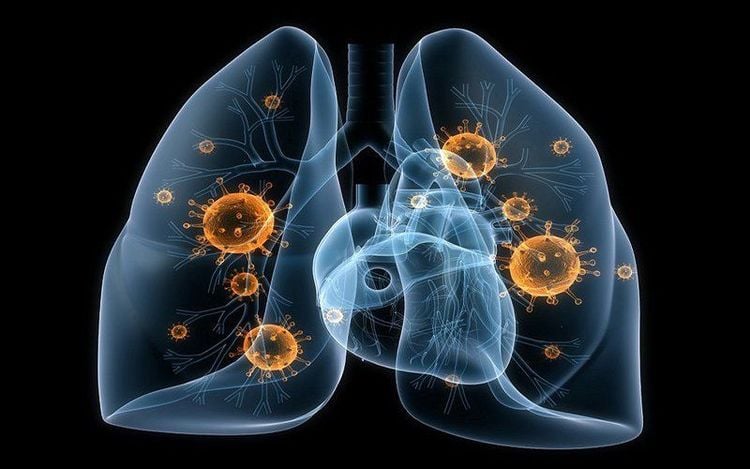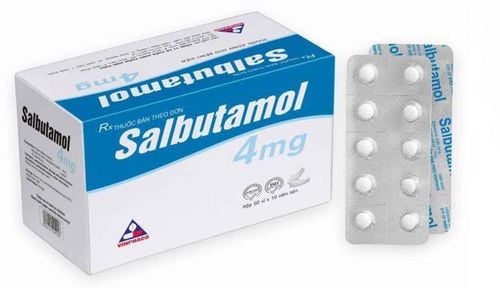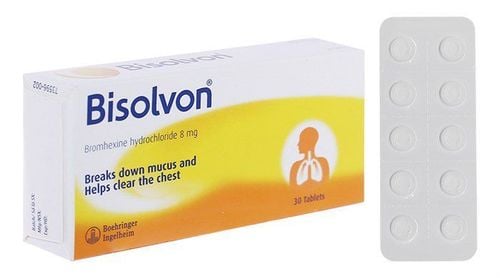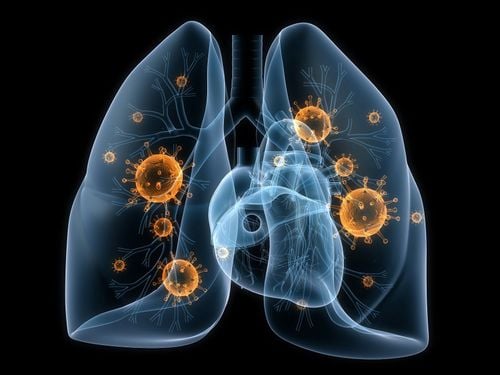This is an automatically translated article.
The article is professionally consulted by Master, Doctor Tong Van Hoan - Emergency Medicine Doctor - Emergency Department - Vinmec Danang International Hospital. Doctor with 10 years of experience in the field of Emergency Resuscitation.When suffering from alveolar disease, the structure of the patient's alveoli is destroyed, the alveoli lose their elasticity and elasticity, the lung's gas exchange function is impaired. If left untreated, alveolar dilatation will cause many complications that seriously affect the patient's health.
1. What is alveolar dilation?
Alveoli are the smallest units in the lung, made up of air sacs arranged like bunches of grapes, located at the ends of the smallest air ducts. The alveoli are very small in size, 0.1-0.2mm in diameter, filled with gas. In adults, there are about 300 million alveoli in the two lungs, making the respiratory surface area of the lungs to reach 100-120 m2. The alveoli play an extremely important role, where gas exchange takes place in the lungs.When breathing in, the chest wall expands, air enters through the air ducts into the alveoli, causing the alveoli to expand to contain a large amount of air. When exhaling, the lung volume shrinks, the alveoli contract to push the air out.
Alveolar dilatation is permanent and irreversible damage to the walls of the air spaces below the terminal bronchioles. When the alveoli are dilated, the structure of the alveoli is destroyed, the elasticity is reduced, and the elasticity is lost, leading to air stagnation, and the gas exchange function of the alveoli is impaired.

2. Causes of alveolar dilation
There are many causes of alveolar dilatation such as:AAT protein deficiency: AAT protein has a protective effect on the elastic structures in the lungs, if this protein is lacking, the enzymes can cause long-term lung damage, leading to dilated disease. alveoli. AAT protein deficiency is an inherited disease, occurring in 1-2% of people with alveolar dilatation. Chronic bronchitis: Chronic bronchitis can be caused by viral, bacterial, parasitic infections or it can be caused by the effects of chemicals, dirt, kitchen smoke, cigarette smoke, pipe smoke .. Prolonged inflammation will spread to the alveoli, causing structural destruction, dilation of the alveoli. Pulmonary TB: TB bacteria damage and fibrosis the alveolar walls and stretch the alveoli. Long-term asthma: Chronic asthma that lasts for many years will cause dilation of the bronchi, alveoli and the capillary system of the lung tissue. Finally, these alveoli are destroyed and cannot be restored. restored to original condition. Inorganic pneumoconiosis: Usually occurs in workers who work in a dusty environment. Common types of lung dust are silicosis, asbestos, coal dust... Inflammatory pneumonitis end bronchial wall infection, fibrosis and alveolar dilation. Thoracic deformity or bronchial narrowing causes bronchial obstruction, alveoli, long-term alveolar dilation. Aging: In the elderly, the lungs work for a long time, leading to fibrosis causing alveolar dilation. In addition, some occupational diseases such as: blowing the trumpet, blowing glass increases the pressure inside the alveoli, causing alveolar dilation. Saccoidose disease: causes arteriosclerosis with alveolar dilation...
3. Is alveolar dilation dangerous?
When the alveoli are dilated, the patient will have symptoms of shortness of breath, wheezing, chest tightness. Shortness of breath is especially increased when doing heavy work, exertion, and fatigue. The patient's chest is deformed, round like a barrel. The lips are purple due to lack of oxygen, the extremities are purple when there is a complication of congestive heart failure. Patients often have a prolonged cough, fatigue, loss of appetite, and weight loss. Epigastric pain due to overactive abdominal muscles,Alveolar disease, if not treated promptly, can cause dangerous complications such as: respiratory failure, pneumothorax, chronic heart failure, arterial blockage lungs, ... seriously affect the patient's health. In particular, in the malignant form, the lung may gradually dissolve because the embryonic parenchyma is gradually destroyed from the two bases. The patient becomes exhausted and usually dies after a few years.

4. How is bronchiectasis treated?
When there are symptoms of the disease, patients need to quickly go to medical facilities for examination and treatment. The principle of treatment for bronchiectasis is to flatten the lungs, reduce the volume of areas containing a lot of air, improve exercise capacity and reduce the work of breathing. The drugs commonly used to treat bronchiectasis are:Bronchodilators: Helps improve overinflated lungs, reduce shortness of breath, increase exercise capacity. Combination of multiple bronchodilators is more beneficial for patients than monotherapy. Corticosteroids can be used in aerosol or oral form, used in acute exacerbation and prophylactic treatment, to help reduce inflammation, reduce disease symptoms, prevent exacerbations of the disease, Oxygen helps reduce respiratory work, increases exercise capacity and prolongation of life in patients. Antibiotics: Used when the patient develops bacterial infections such as bronchitis or pneumonia. Along with medical treatment, patients need active lifestyle changes. Quit smoking completely to reduce the progression of the disease, practice pursed-lip breathing to help reduce air retention in the chest, reduce shortness of breath. Strengthen training, improve physical condition to increase resistance.
To prevent alveolar disease, it is necessary to maintain respiratory health. Do not smoke, pipe tobacco, when you have a respiratory infection, you need to treat it completely, not to let the disease prolong. Maintain oral hygiene, keep the living and working environment clean. Wear protective gear when working in a dusty environment. In addition, it is necessary to regularly improve physical condition by using vitamins A, C, E and group B. Instruct the patient to exercise, qigong, to practice abdominal breathing.
Please dial HOTLINE for more information or register for an appointment HERE. Download MyVinmec app to make appointments faster and to manage your bookings easily.














